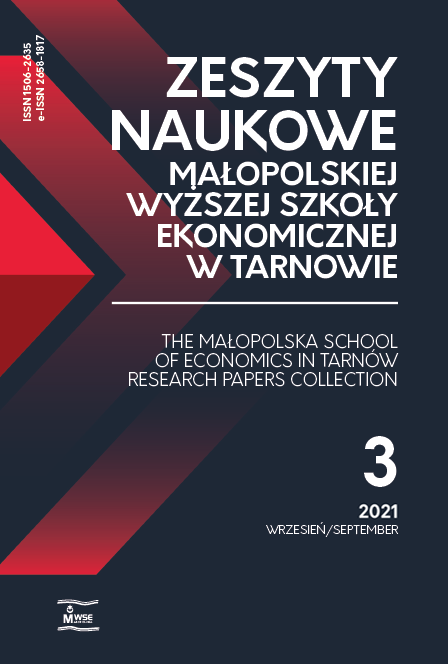Abstract
Lintner’s (1956) partial adjustment model identifies the company’s long-term dividend policy by setting a dividend target payout ratio and the speed of adjustment. And although the model has undergone various modifications and methods of estimation over more than 60 years, it is still a good tool for analyzing dividend decisions made by companies. The aim of the article is to show the usefulness of the Lintner model for analyzing changes in the company’s dividend policy during the pandemic turmoil. For the illustration, Hydrotor SA was chosen, which, the longest time at the Warsaw Stock Exchange, continuously pays dividends. The calculations showed that the situation in 2020 resulted in a revision of the company’s long-term dividend strategy, which resulted in a lowering of the dividend target payout ratio and a greater attention to the current situation (current net profits)—an increase in the speed of adjustment.
References
Anderson, T. W., Hsiao, C. (1981). Estimation of dynamic models with error components. Journal of American Statistical Association, 76(375), 598–606. DOI: 10.2307/2287517.
View in Google Scholar
Andres, Ch., Doumet, M., Fernau, E., Theissen, E. (2015). The Lintner model revisited: Dividends versus total payouts. Journal of Banking & Finance, 55, 56–69. DOI: 10.1016/j.jbankfin.2015.01.005.
View in Google Scholar
Angrist, J. D., Krueger, A. B. (2001). Instrumental variables and the search for identification: From supply and demand to natural experiments. Journal of Economic Perspectives, 15(4), 69–85.
View in Google Scholar
Arellano, M., Bond, S. (1991). Some tests of specification for panel data: Monte Carlo evidence and an application to employment equations. Review of Economic Studies, 58(2), 277–297. DOI: 10.2307/2297968.
View in Google Scholar
Cottrell, A., Lucchetti, R. (2021). Gretl user’s guide [online, accessed: 2021-03-03]. Retrieved from: http://ricardo.ecn.wfu.edu/pub/gretl/gretl-guide.pdf.
View in Google Scholar
Fama, E. F., French, K. R. (2002). Testing trade-off and pecking order predictions about dividends and debt. The Review of Financial Studies, 15(1), 1–33. DOI: 10.1093/rfs/15.1.1.
View in Google Scholar
Fama, E., Babiak, H. (1968). Dividend policy: An empirical analysis. Journal of the American Statistical Association, 63(324), 1132–1161.
View in Google Scholar
Fama, E. F., MacBeth, J. D. (1973). Risk, return and equilibrium: Empirical tests. Journal of Political Economy, 81(3), 607–636.
View in Google Scholar
Fernau, E., Hirsch, S. (2019). What drives dividend smoothing? A meta regression analysis of the Lintner model. International Review of Financial Analysis, 61, 255–273.
View in Google Scholar
Gostkowska-Drzewicka, M., Majerowska, E. (2016). The relevance of dividend smoothing in the construction companies listed on the Warsaw Stock Exchange. Nauki o Finansach / Financial Sciences, 2(27), 9–22. DOI: 10.15611/nof.2016.2.01.
View in Google Scholar
Greene, W. H. (2003). Econometric Analysis. 5th ed. Upper Saddle River. NJ: Pearson Eduction, Inc. ISBN: 0130661899.
View in Google Scholar
Hydrotor SA. (2020). [online, accessed: 2021-03-03]. Report on the activities of Hydrotor SA and Hydrotor Capital Group in the first half of 2020. Retrieved from: http://www.hydrotor.pl/relacje-inwestorskie/#1460668645137-c1c56e1b-306a.
View in Google Scholar
Koop, G. (2014). Wprowadzenie do ekonometrii. Warszawa: Oficyna a Wolters Kluwer business. ISBN 9788326431913.
View in Google Scholar
Kowerski, M. (2011). Ekonomiczne uwarunkowania decyzji o wypłatach dywidend przez spółki publiczne. Wydawnictwo Konsorcjum Akademickie: WSE w Krakowie, WSIZ w Rzeszowie, WSZiA w Zamościu. ISBN 9788362259281.
View in Google Scholar
Kowerski, M. (2013). Model częściowych dopasowań dywidend Lintnera dla Giełdy Papierów Wartościowych w Warszawie. Annales Universitatis Mariae Curie-Skłodowska. Sectio H, Oeconomia, 47(3), 337–346. DOI: 10.17951/h.2013.47.3.337.
View in Google Scholar
Kowerski, M., Wypych, M. (2016). Ownership structure and dividend strategy of public companies. Evidence from Poland. Barometr Regionalny. Analizy i Prognozy, 14(4), 179–192.
View in Google Scholar
Kufel, T. (2018). Ekonometria, Rozwiązywanie problemów z wykorzystaniem programu GRETL. Warszawa: Wydawnictwo Naukowe PWN. ISBN: 9788301165130.
View in Google Scholar
Lintner, J. (1956). Distribution of incomes of corporation among dividends, retained earnings and taxes. American Economic Review, 46(2), 97–113.
View in Google Scholar
Maddala, G. S. (2020). Ekonometria. Warszawa: Wydawnictwo Naukowe PWN. ISBN 9788301156947.
View in Google Scholar
Nowak, S., Mosionek-Schweda, M., Mrzygłód, U., Kwiatkowski, J. (2017). Greedy state? The effect of the government shareholder on the dividend payout ratio and smoothing levels. International Journal of Contemporary Management, 16(4), 119–143. DOI: 10.4467/24498939IJCM.17.041.8264.
View in Google Scholar
Paliwoda, G. (1997). Przegląd matematycznych modeli ustalania poziomu wypłat dywidendy. Zeszyty Naukowe AE w Krakowie, 480, 75–83.
View in Google Scholar
Pesaran, M. H., Taylor, L. (1999). Diagnostics for IV regressions. Oxford Bulletin of Economics and Statistics, 61(2), 255–281.
View in Google Scholar
Renneboog, L., Szilagyi, P. G. (2020). How relevant is dividend policy under low shareholder protection. Journal of International Financial Markets Institutions and Money, 64, 1–18. DOI: 10.1016/j.intfin.2015.01.006.
View in Google Scholar
Sharpe, W. F. (1963). A simplified model of portfolio analysis. Management Science, 9/2, 277–293.
View in Google Scholar
Skinner, D. J. (2008). The evolving relation between earnings, dividends, and stock repurchases. Journal of Financial Economics, 87(3), 582–609.
View in Google Scholar
Stock, J., Yogo, M. (2005). Testing for weak instruments in linear IV regression. In: D. W. K. Andrews (ed.). Identification and inference for econometric models (pp. 80–108). New York: Cambridge University Press. ISBN: 9780521844413.
View in Google Scholar
Wójcikowska, U., Wójcikowski, R. (2008). Polityka dywidendy a struktura akcjonariatu: studium przypadku z użyciem modelu Lintnera. Studia i Prace Wydziału Nauk Ekonomicznych i Zarządzania Uniwersytetu Szczecińskiego, 10, 320–326.
View in Google Scholar
Wright, P. G. (1928). Appendix B: Effects of a duty on price and output with special reference to butter and flaxseed. In: P. G. Wright (ed.). The tariff on animal and vegetable oils (pp. 286–319). New York: MacMillan.
View in Google Scholar

This work is licensed under a Creative Commons Attribution-NonCommercial-NoDerivatives 4.0 International License.

